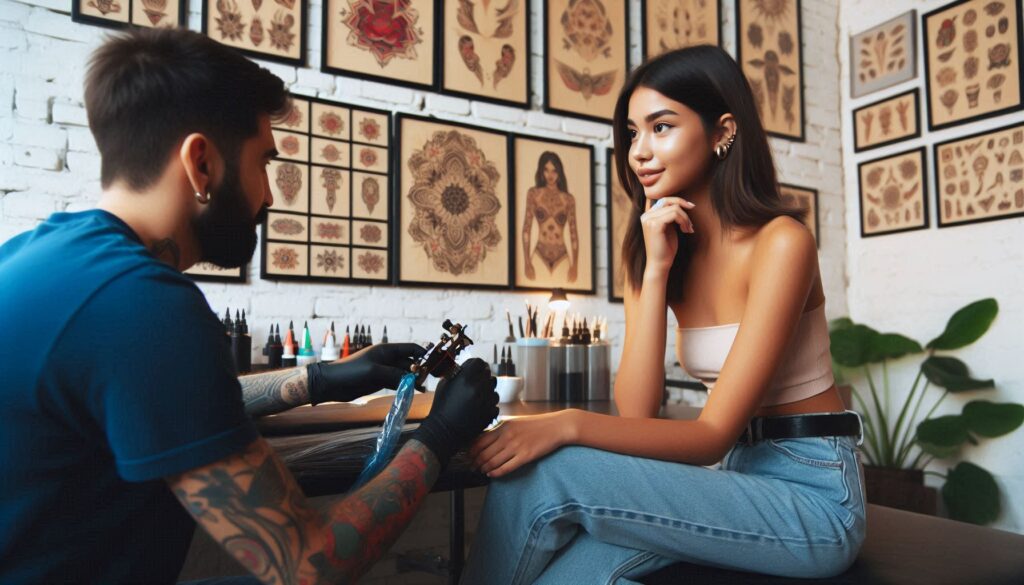How to Prepare for Your First Tattoo: Tips for Australians
So, you’ve finally made the decision. You’re getting your first tattoo. For many Australians, the process of planning that first piece of ink is exciting yet nerve-wracking. Whether it’s a small symbol with deep personal meaning or an intricate design you’ve always dreamed of, the idea of getting a tattoo is a significant milestone. But if this is your first time, you might have more questions than answers. What should you do before the big day? How can you make sure everything goes smoothly? Most importantly, how do you ensure that you’re mentally and physically ready for this lifelong piece of art?

From picking the right design to caring for your tattoo once the ink has settled, there’s a lot to consider. But don’t worry—getting your first tattoo doesn’t have to be stressful. Here’s a breakdown of how to prepare for your first tattoo, especially for Australians who want to make sure their first tattoo experience Down Under is as smooth as possible.
1. Choose the Right Tattoo Studio and Artist
First things first: finding the right tattoo artist and studio is absolutely essential. Australia is home to a thriving tattoo culture, with studios popping up in every corner of the country, from the laid-back beachside suburbs to bustling city centres. But with so many choices, it can feel overwhelming.
Your artist should be someone whose style matches your vision. Some tattooists excel at fine line work, others specialize in bold, colourful designs. Look at their portfolios to see if their artistic flair aligns with what you want. Word of mouth is also a powerful tool—ask friends or family who have tattoos for recommendations, or check online reviews.
If you’re unsure where to start, Tattoos Down Under has a diverse team of experienced artists who can guide you through the process. Whether you’re looking for traditional designs or modern tattoo styles, you’re bound to find an artist who can bring your idea to life.
2. Pick a Design That Speaks to You
One of the most exciting (and potentially overwhelming) parts of getting your first tattoo is picking the right design. The beauty of tattoos is that they’re deeply personal, allowing you to express yourself in a permanent and meaningful way. So, it’s essential to choose a design that resonates with you.
Ask yourself, what’s the significance of the tattoo? Is it a symbol of a personal milestone, a loved one, or just an artistic expression that you love? Some Australians opt for tattoos that connect them to their culture or environment—whether it’s native flora and fauna or Aboriginal-inspired designs, the possibilities are endless.
Keep in mind that your tattoo doesn’t need to have an elaborate backstory to be meaningful. Sometimes, a design is simply beautiful or intriguing, and that’s enough. It’s important to remember that your tattoo is yours, and as long as it feels right to you, that’s all that matters.
3. Decide Where to Place Your Tattoo
Once you’ve picked your design, you’ll need to figure out where to put it. The placement of your tattoo is as important as the design itself. Different parts of your body will react differently to the tattooing process, and your choice of placement can influence how much the tattoo will hurt and how well it will heal.
For first-timers, areas with thicker skin and fewer nerve endings, such as the upper arm, thigh, or calf, might be less painful. On the flip side, tattoos on areas like the ribs, feet, or spine are known for being more intense. Consider not only your pain tolerance but also how visible you want your tattoo to be. Some Australians prefer to keep their tattoos easily hidden for professional reasons, while others are happy to display their ink proudly.
Additionally, think about how the tattoo will age. Areas exposed to the sun, like your hands, forearms, or neck, may fade faster than areas that are usually covered, especially given Australia’s sunny climate. It’s worth discussing this with your artist so you can make an informed decision.
4. Stay Hydrated and Take Care of Your Skin
Your skin is the canvas for your tattoo, so it’s crucial to make sure it’s in the best condition possible. Start prepping your skin weeks before your appointment by staying well-hydrated. Drink plenty of water to keep your skin supple and moisturized. Dry, flaky skin can make the tattooing process more difficult and may affect how well the ink takes to your skin.
It’s also important to avoid excessive sun exposure in the days leading up to your tattoo. Sunburnt skin is not only painful, but it’s also more prone to peeling and blistering, which can affect the quality of the tattoo. Since Australia’s UV index is typically high, wearing sunscreen and staying out of the sun is vital.
If you have any skin conditions, such as eczema or psoriasis, make sure to consult with your tattoo artist beforehand. They’ll be able to advise you on whether it’s safe to tattoo over affected areas and what precautions to take.
5. Get a Good Night’s Sleep
You’d be surprised how much a good night’s sleep can affect your tattooing experience. Being well-rested helps reduce anxiety and increases your pain tolerance. Tattooing, especially if it’s a large piece, can be both physically and mentally taxing. Walking into the studio after a night of poor sleep can make the process feel more draining and uncomfortable than it needs to be.

Make sure to avoid drinking alcohol or taking drugs the night before your tattoo appointment. Alcohol thins the blood, which can increase bleeding during the tattooing process and affect how well the ink sets. Additionally, both alcohol and drugs can impair your judgment, and you’ll want to be fully clear-headed during your session.
6. Eat a Hearty Meal Before Your Session
Tattooing can take hours, and it’s not uncommon for first-timers to underestimate how taxing the process can be on the body. One of the most practical things you can do is to eat a hearty, balanced meal before your appointment. This ensures that your blood sugar levels remain stable and helps you avoid feeling lightheaded or faint during the session.
Tattooing burns more calories than most people realize—your body is essentially undergoing a controlled injury, and your metabolism kicks into gear. Avoiding hunger pangs by eating a proper meal will keep you comfortable and focused.
7. Dress Comfortably
When it comes to your tattoo session, comfort is key. Wear loose-fitting, breathable clothing that gives your artist easy access to the area being tattooed. If you’re getting a tattoo on your upper body, consider wearing a tank top or something that allows you to expose the area without feeling restricted.
Remember, tattooing can take a few hours, especially if you’re getting a larger piece, so you’ll want to feel comfortable while sitting or lying down for an extended period. Layers can also be a good idea, especially in a country like Australia where the temperature can fluctuate, or the air conditioning might feel a bit chilly in the studio.
8. Bring Distractions (But Stay Engaged)
Long tattoo sessions can sometimes feel monotonous, especially if you’re sitting still for hours on end. Bringing a distraction, like a book, some music, or a podcast, can help pass the time. Some Australians enjoy using their phones or tablets to watch shows or movies while they get tattooed. Just make sure that your device doesn’t interfere with the artist’s space, and remember that you may need to stay still, especially if the tattoo is in a sensitive area.
That said, it’s also a good idea to stay somewhat engaged in the process. Tattooing is a collaboration between you and the artist, and they may need to check in with you periodically about positioning, comfort, or even details of the design. Being responsive and alert can help ensure that everything goes smoothly.
9. Communicate with Your Artist
Communication is key when it comes to tattooing. Don’t be afraid to ask questions or voice concerns, whether it’s about the design, placement, or the tattooing process itself. Tattoo artists are professionals who want you to feel comfortable and confident throughout the session. In fact, many artists will encourage a dialogue to ensure you’re happy with the final product.
If at any point you’re feeling unsure or need a break, let your artist know. Tattooing is a physical and emotional experience, and there’s no harm in taking a few moments to gather yourself. Whether you’re feeling anxious, experiencing more pain than expected, or simply need to stretch, your artist is there to support you.
10. Plan for Aftercare
Once the tattoo is finished, the real work begins—aftercare. Your tattoo is essentially an open wound, and it needs to be cared for properly to heal well and maintain its vibrancy. Your artist will provide you with aftercare instructions, which might include keeping the tattoo clean, avoiding direct sunlight, and using a special ointment or moisturizer to help the healing process.
Given Australia’s climate, it’s important to be particularly mindful of sun exposure. A fresh tattoo is especially vulnerable to UV damage, so make sure to keep it covered when outdoors, and once it’s fully healed, apply sunscreen regularly to prevent fading.

The healing process can take anywhere from a few weeks to a couple of months, depending on the size and placement of the tattoo. Be patient and follow the aftercare advice carefully to ensure your tattoo looks its best for years to come.
Preparing for your first tattoo is an exciting journey, but taking the time to get everything right will make all the difference in your experience. From choosing the perfect design and studio to ensuring your body is ready for the session, these steps will help you feel confident and prepared. At Tattoos Down Under, we’re passionate about guiding our clients through the tattoo process with care and expertise. Whether you’re a first-timer or adding to your collection, our artists are ready to help you create something you’ll love forever.


Leave a Reply